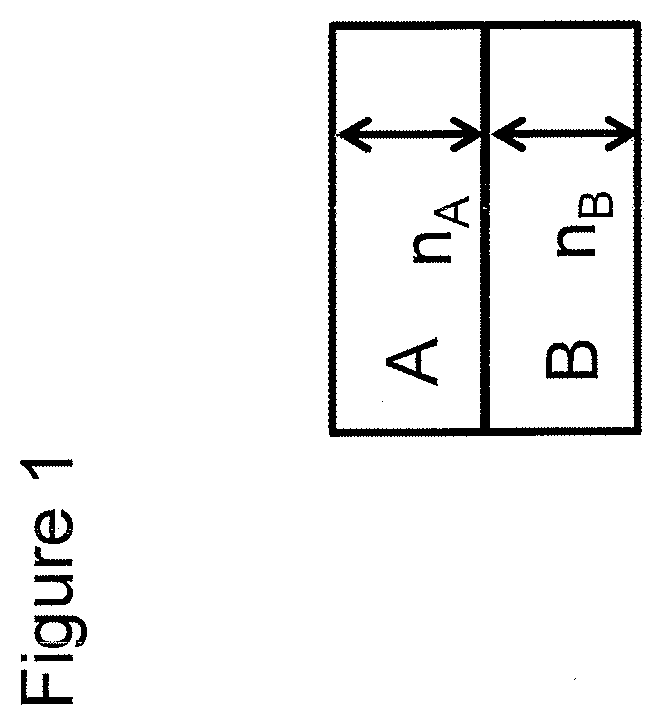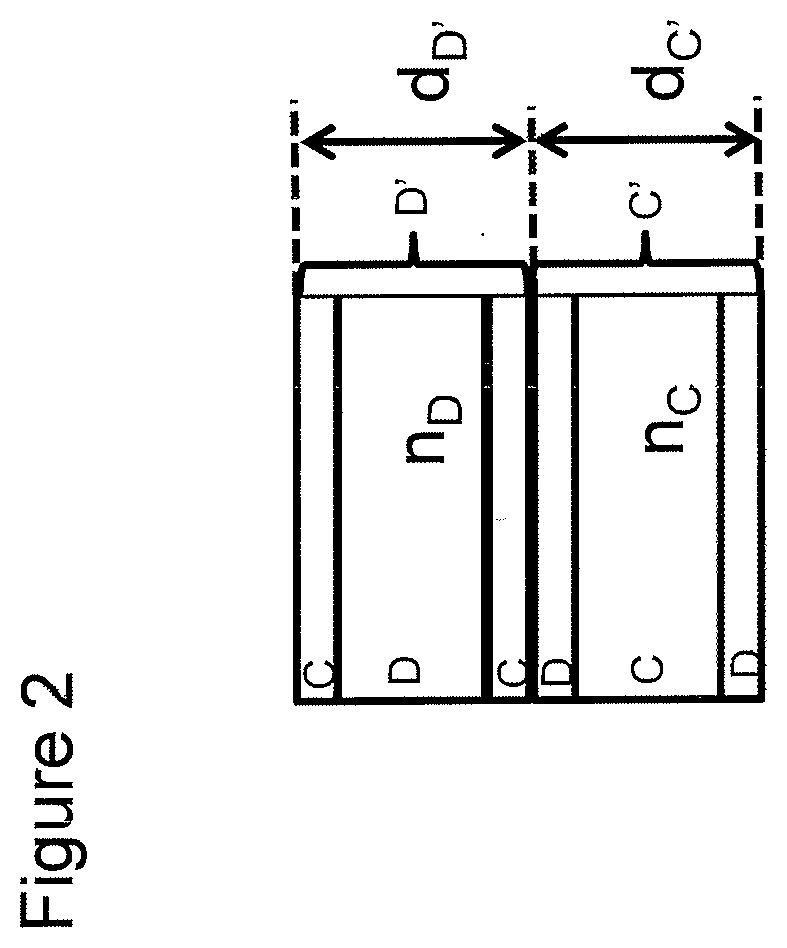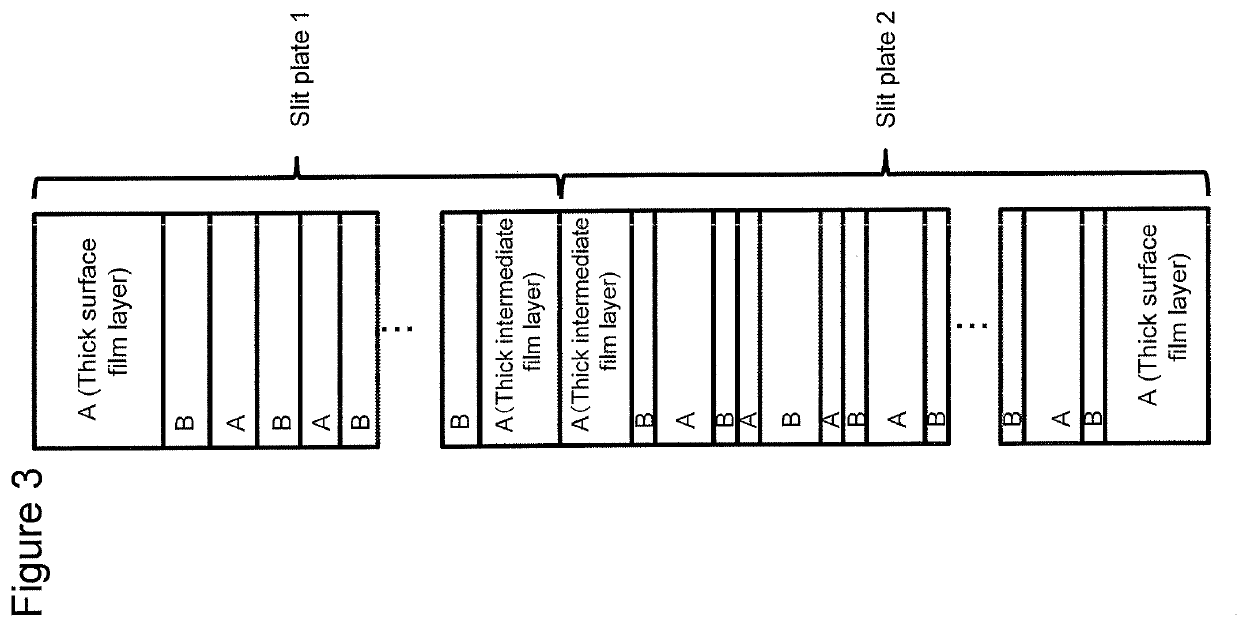Film and layered body
- Summary
- Abstract
- Description
- Claims
- Application Information
AI Technical Summary
Benefits of technology
Problems solved by technology
Method used
Image
Examples
example 1
[0137]A PEN polymer with an intrinsic viscosity of 0.60 and a Tm of 268° C. was used as thermoplastic resin C whereas a mixture of a copolymer of a PET resin with 30 mol % cyclohexanedimethanol and a polyethylene terephthalate polymer (manufactured by Toray Industries, Inc.; IV 0.65, Tg 79° C., Tm 255° C.) mixed at a mass ratio of 82:18 was used as thermoplastic resin D (shown as PETG resin in Tables), and the lamination apparatus was replaced with lamination apparatus 2. Except for these, the same procedure as in Comparative example 1 was carried out. Lamination apparatus 2 was designed for only a thick layer of 7 μm, a thick intermediate layer of 3 μm, both located at each surface, and lamination unit 2 containing 654 layers and configured to produce a laminated film having a total of 657 stacked layers in the following layer constitution: (thick surface layer of thermoplastic resin C) / (lamination unit 2 containing a total of 327 C-layers and D-layers stacked alternately in the th...
example 2
[0141]Except for using lamination apparatus 3, the same procedure as in Example 1 was carried out. Lamination apparatus 3 had a layer thickness constitution designed for forming a 5 μm layer as a thick surface layer and lamination unit 1 of 149 layers, subsequently forming a thick intermediate layer of 5 μm and lamination unit 2 of 297 layers, and additionally forming a 5 μm layer as the thick surface layer on the lamination unit 2 side to produce a laminated film (total thickness of 60 μm) containing a total of 449 stacked layers in the following layer constitution: (thick surface layer of thermoplastic resin A) / (lamination unit 1 containing a total of 149 A-layers and B-layers stacked alternately in the thickness direction) / (thick intermediate layer of thermoplastic resin A) / (lamination unit 2 containing a total of 297 C-layers and D-layers stacked alternately in the thickness direction) / (thick surface layer of thermoplastic resin A). The total thickness (d1) of lamination unit 1 ...
example 3
[0143]Except for using lamination apparatus 4, the same procedure as in Example 2 was carried out. Lamination apparatus 4 had a layer thickness constitution designed for forming a 6 μm layer as a thick surface layer and lamination unit 1 of 149 layers, subsequently forming a thick intermediate layer of 5 μm and lamination unit 2 of 357 layers, and additionally forming a 4 μm layer as the thick surface layer on the lamination unit 2 side to produce a laminated film (total thickness of 63 μm) containing a total of 599 stacked layers in the following layer constitution: (thick surface layer of thermoplastic resin A) / (lamination unit 1 containing a total of 149 A-layers and B-layers stacked alternately in the thickness direction) / (thick intermediate layer of thermoplastic resin A) / (lamination unit 2 containing a total of 357 C-layers and D-layers stacked alternately in the thickness direction) / (thick surface layer of thermoplastic resin A). The total thickness (d1) of lamination unit 1 ...
PUM
| Property | Measurement | Unit |
|---|---|---|
| Fraction | aaaaa | aaaaa |
| Fraction | aaaaa | aaaaa |
| Thickness | aaaaa | aaaaa |
Abstract
Description
Claims
Application Information
 Login to View More
Login to View More - R&D
- Intellectual Property
- Life Sciences
- Materials
- Tech Scout
- Unparalleled Data Quality
- Higher Quality Content
- 60% Fewer Hallucinations
Browse by: Latest US Patents, China's latest patents, Technical Efficacy Thesaurus, Application Domain, Technology Topic, Popular Technical Reports.
© 2025 PatSnap. All rights reserved.Legal|Privacy policy|Modern Slavery Act Transparency Statement|Sitemap|About US| Contact US: help@patsnap.com



